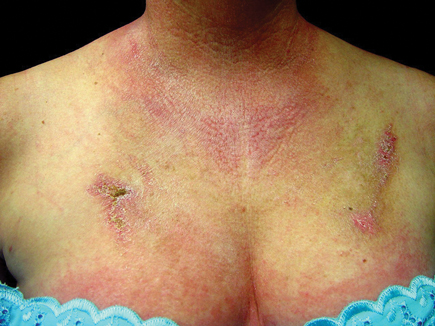MKSAP Quiz: Intermittent abdominal discomfort
A 61-year-old woman is evaluated for intermittent abdominal discomfort and a bloating sensation. Approximately 2 months before the swelling started, the patient had a pruritic, gradually progressive rash characterized by redness of the face, and a pruritic rash on her chest, upper back, shoulders, hands, and lateral hips. She has no muscle pain, weakness, or joint pain. Pertinent family history includes breast cancer in her mother and ovarian cancer in her grandmother. Mammogram, Pap test, and colonoscopy, all performed within the last year, were normal.
On physical examination, vital signs are normal. BMI is 30. There is violaceous erythema of the periorbital region. She has reticulate and poikilodermatous erythema of the V-neck of the chest with areas of cutaneous ulceration. There are small, flat-topped erythematous papules over the distal and proximal interphalangeal joints. Skin findings are shown.

Lungs are clear. There is no lymphadenopathy or hepatosplenomegaly. There is trace lower extremity edema. The patient has normal strength and no difficulty raising her arms or rising from a chair without using her arms to help. Pelvic examination is normal.
Laboratory findings reveal normal complete blood count, comprehensive metabolic profile, and serum aminotransferase, creatine kinase, and aldolase levels. Electromyogram of the right arm and leg is normal.
Which of the following is the most appropriate diagnostic study for this patient?
A. Antinuclear antibody serologic testing
B. Serum CA 19-9 and carcinoembryonic antigen measurement
C. Thigh muscle biopsy
D. Transvaginal ultrasound
Answer and critique
The correct answer is D: Transvaginal ultrasound. This question can be found in MKSAP 16 in the Dermatology section, item 40.
The most appropriate diagnostic study for this patient is a transvaginal ultrasound. It is likely that this patient has amyopathic dermatomyositis, a condition characterized by the typical rash and histologic findings of dermatomyositis but in the absence of clinical myopathy. In these patients, as well as in patients with classic dermatomyositis, ovarian cancers are overrepresented, and these patients should be evaluated with appropriate imaging. Patients with dermatomyositis and cutaneous ulcerations may be at an even higher risk of malignancy. Given this patient's symptoms of increasing abdominal girth, along with her family history, ovarian cancer is a reasonable concern.
Antinuclear antibody (ANA) serologic testing may be useful in the diagnosis of autoimmune diseases and is frequently positive in dermatomyositis. A negative ANA, however, would not exclude a diagnosis of dermatomyositis, and ANA status would not alter the evaluation or management of this patient.
Carcinoembryonic antigen is a nonspecific tumor marker that may be elevated in the presence of colon cancer, as well as other tumors such as pancreatic, gastric, lung, and breast; it is an inadequate screening and diagnostic test. The CA 19-9 level is elevated in subsets of colon, gastric, and pancreatic tumors. Neither is likely to help identify the most likely diagnosis in this patient.
Thigh muscle biopsy is not indicated in this patient. Dermatomyositis may be diagnosed without muscle inflammation in patients with amyopathic dermatomyositis or those with minimal muscle disease, known as hypomyopathic dermatomyositis. A blind muscle biopsy is low yield. If the patient were having symptoms of muscle pain or weakness, a muscle biopsy would be indicated. The presence of a negative electromyogram, normal serum aminotransferase levels, and normal creatine kinase and aldolase levels make active muscle inflammation unlikely.
Key point
- All patients with a new diagnosis of dermatomyositis should undergo age- and sex-appropriate cancer screening.




